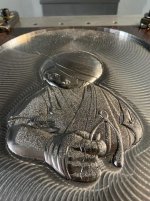So, I have successfully surfaced this with a 1/16th ball mill a couple times. All the other times is comes out like this photo attached. Really fuzzy and raspy on the flats.
I am running it at MAX rpm for the mill (11,500. I know 20k or 30k would be better but aint got it.) and at about .0005 IPT chipload and .0035" stepover, attempted with both scallop and raster(parallel) toolpaths. Tried with both 2 and 4 flute endmills and only had success a couple times.
A few questions I have are, given the 3d shapes, how much should I leave for the ball? I've been trying .003 before the final pass but should I do more? .010 or .012? Im stumped... Tried everything.. Maybe more chipload?

I am running it at MAX rpm for the mill (11,500. I know 20k or 30k would be better but aint got it.) and at about .0005 IPT chipload and .0035" stepover, attempted with both scallop and raster(parallel) toolpaths. Tried with both 2 and 4 flute endmills and only had success a couple times.
A few questions I have are, given the 3d shapes, how much should I leave for the ball? I've been trying .003 before the final pass but should I do more? .010 or .012? Im stumped... Tried everything.. Maybe more chipload?


